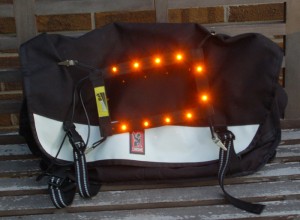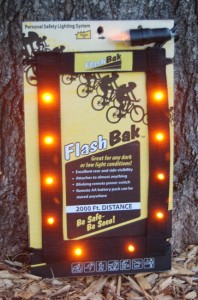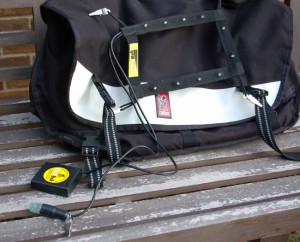 For the last couple months, I have been trying out a product called FlashBak. As you can see in the pictures, the FlashBak is a rectangle made from heavy-duty nylon strap with 10 embedded flashing LEDs. Four clips on the corners with elastic cords hold the unit in place and the 3 AAA batteries are encased in a separate pack that is easily storable in a bag or pocket. The on-off switch for the lights is on a cord and can be clipped in front, to a bag strap or to your clothing. That remote switch has an LED light in it, so you know at a quick glance whether the lights on you back are on or off. That is a really nice feature; there is no need to reach your hand around and look for reflected light to see if it is working (as I sometimes did with the smaller blinking lights that I clipped to my bag previously).
For the last couple months, I have been trying out a product called FlashBak. As you can see in the pictures, the FlashBak is a rectangle made from heavy-duty nylon strap with 10 embedded flashing LEDs. Four clips on the corners with elastic cords hold the unit in place and the 3 AAA batteries are encased in a separate pack that is easily storable in a bag or pocket. The on-off switch for the lights is on a cord and can be clipped in front, to a bag strap or to your clothing. That remote switch has an LED light in it, so you know at a quick glance whether the lights on you back are on or off. That is a really nice feature; there is no need to reach your hand around and look for reflected light to see if it is working (as I sometimes did with the smaller blinking lights that I clipped to my bag previously).
I received this product for review in mid March, immediately after Daylight Saving Time had begun. That was great timing because, even with the days getting longer, my morning rides were all of the sudden starting in the dark. The first time I turned the Flashbak on, I was impressed with the brightness of the lights…even in full daylight. You can see in the pictures of the product lit that the individual LEDs are extremely bright. Flashing all together, they definitely make an impression.
 At first, I only used the FlashBak when it was dark out, but lately I have been using it for my commute all the time, even in daylight. This morning (for Bike to Work Day), it was overcast with light drizzle. I attended our local ride with the Mayor, and ended up riding in to work later than normal…and on a busier road than I would regularly ride. With the rush hour traffic and the light rain, I was glad to have the FlashBak on my back for a little extra visibility. My commuter bike has two red LED taillights, one on the seatpost and one on my trunk pack. The Flashbak is a great supplement to those lights because it is larger, brighter, and positioned higher (on my back).
At first, I only used the FlashBak when it was dark out, but lately I have been using it for my commute all the time, even in daylight. This morning (for Bike to Work Day), it was overcast with light drizzle. I attended our local ride with the Mayor, and ended up riding in to work later than normal…and on a busier road than I would regularly ride. With the rush hour traffic and the light rain, I was glad to have the FlashBak on my back for a little extra visibility. My commuter bike has two red LED taillights, one on the seatpost and one on my trunk pack. The Flashbak is a great supplement to those lights because it is larger, brighter, and positioned higher (on my back).
I mentioned the light rain this morning. I have ridden with the Flashbak previously in rain before with no problems. The electronics that drive the LEDs are housed in the battery compartment, which I keep stowed away in my messenger bag. That part has stayed dry on all of my rides, but the external part can get wet and still function just fine. From the look of the sky right now, I am pretty sure I will be testing it in the rain again on my ride home this afternoon.
 The vast majority of times I have used the Flashbak, it has been fastened to my bag as seen in the pictures. The serrated alligator clips do a good job of holding it securely in place to the straps of the bag. When I first received the Flashbak, I did a short night ride with a clipped to a t-shirt. It is a bit tricky to clip to your own shirt, but doable…kind of like pinning on your own race number. The clips work very well on a variety of fabrics, but I never tried them on any of my lycra jerseys (I was concerned that the serrated clips might harm the fabric). I never used it on recreational rides anyway though, so for me the messenger bag has been the perfect place for the Flashbak to reside. Clipped to the outside flap, it is kind of like part of the bag now.
The vast majority of times I have used the Flashbak, it has been fastened to my bag as seen in the pictures. The serrated alligator clips do a good job of holding it securely in place to the straps of the bag. When I first received the Flashbak, I did a short night ride with a clipped to a t-shirt. It is a bit tricky to clip to your own shirt, but doable…kind of like pinning on your own race number. The clips work very well on a variety of fabrics, but I never tried them on any of my lycra jerseys (I was concerned that the serrated clips might harm the fabric). I never used it on recreational rides anyway though, so for me the messenger bag has been the perfect place for the Flashbak to reside. Clipped to the outside flap, it is kind of like part of the bag now.
Overall, I think the Flashbak is a great safety product, especially for commuters. You can read more about it at the company’s website or in this thorough review at BikeCommuters.com. For 45 bucks, it seems like a worthwhile investment for anyone who rides in the dark or on roads with a lot of traffic. I definitely plan to continue using mine for commuting and urban riding.
Disclaimer: Pulse Wave Technology, the company that makes Flashbak, sent me this product at no charge to review. No money was exchanged or anything like that…I am just giving my honest opinion after using it for a while.

Leave a Reply